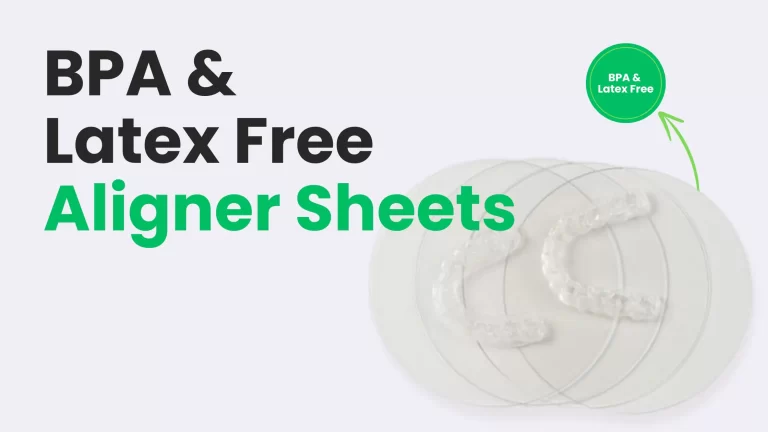Enquire Form
BPA Latex Free Aligner Sheets – A Safe Choice for Orthodontic Treatment

Giving your patients a straighter smile requires putting some thought into the treatment plan and the materials essential to the process. When your patients choose to get clear aligners, the material quality of the aligner sheets is an important consideration. Choosing inferior materials can affect orthodontic treatment outcomes in such a way that it can go beyond just aesthetic considerations.
Some of the Important Factors to Consider Are as Follows:
Effect on Comfort and Fit:
If your patient wears aligners made of poor-quality sheets, they might require more adjustments for a snug fit, which could cause discomfort. Unfit aligners can irritate the soft tissues like the gums and cheeks and hamper the course of treatment. Comfort is not only a luxury but also a necessity. It guarantees patient compliance during therapy.
Durability Is Important:
We’re sure that you’re aware of how durability is crucial since clear aligners are worn for extended periods. Poor-quality materials must be frequently replaced since they are more likely to wear out and break. This causes unnecessary inconvenience for your patient and the orthodontic office. It also greatly hampers the treatment schedule.
Effectiveness of Tooth Movement:
The capacity of aligners to apply exact pressure for tooth movement is critical to the outcome of orthodontic therapy. Low-quality materials lack the ideal elasticity and strength required for effective tooth movement. This may lead to less-than-ideal results and a longer course of treatment.
Importance of Using BPA & Latex-Free Aligner Sheets
The selection of materials becomes crucial in the quest to produce transparent aligners that are safe and effective for patients. Two substances that have sparked concerns across various businesses, including the healthcare sector, are latex and BPA (bisphenol A). Choosing aligner sheets free of these compounds is crucial because of their potential to cause possible hazards.
Some possible side effects of BPA include-
Endocrine Disruption:
BPA can interfere with the endocrine system’s normal function. Prolonged exposure can cause multiple issues like reproductive disorders, hormone imbalances, and developmental abnormalities.
Toxicity:
Many studies show that BPA may have toxic effects on the brain, nervous system, and other organs. They have linked BPA exposure to brain disorders, behavioural changes, and other issues.
Carcinogenicity:
Some studies also show that there is a relation between BPA exposure and a higher risk of some cancers like breast cancer, prostate cancer, and more.
Allergic Reactions:
Some individuals may experience allergic reactions to BPA used in aligner materials. Symptoms may include skin irritation, inflammation, or swelling in the mouth or surrounding tissues.
The last thing we want in orthodontics is a material that could cause such health problems.
Allergies and Sensitivities to Latex:
Certain people have been reported to experience allergies to latex, a natural rubber substance. Latex allergies can cause anything from minor irritability to extremely serious and potentially fatal reactions. A proactive measure to ensure patient safety and reduce the possibility of adverse reactions is to choose latex-free materials for aligners. This is because of their close and constant contact with oral tissues.
Why Choose Aligner Sheets Free of Latex and BPA?
Choosing aligner sheets free of BPA and latex is a deliberate choice made with the safety and well-being of the patient in mind. Orthodontic practices can now offer a solution that not only aligns teeth but also meets the highest requirements for safety and health by removing these potentially dangerous ingredients from the aligner material.
How Do BPA and Latex-Free Aligner Sheets Affect the Orthodontic Treatment Experience?
Beyond safety issues, the choice of aligner sheets directly impacts how well your patients feel about their orthodontic treatment. The path to a straighter smile can be enjoyable and comfortable when using aligner sheets free of latex and BPA.
Increased Comfort:
Patient comfort is improved by aligner sheets’ lack of latex and BPA. Reduced irritation and allergic responses enable patients to wear their aligners painlessly for the entire prescribed time.
Higher Level of Compliance:
Increased patient compliance is correlated with more comfortable aligners. Patients are more likely to follow the recommended wear schedule when aligners don’t have any potentially dangerous substances, enhancing the treatment plan’s efficacy.
Peace of Mind:
BPA and latex-free aligner sheets give patients and orthodontists peace of mind. Everyone concerned may concentrate on the beneficial effects of the treatment because there are no unanswered questions regarding the possible effects of the materials on health.
Crafted using cutting-edge technology and premium materials, Taglus provides BPA and Latex free Aligner Sheets. Taglus stands as a beacon of quality in the dental industry, empowering practitioners to deliver exceptional patient outcomes while ensuring safe and secure dental treatment journey.
Summary:
In summary, getting a straighter smile is a journey rather than a destination. The materials used to make clear aligners are crucial to the patient’s treatment success, safety, and comfort. It is important for orthodontic clinics to put the health of their patients first and provide a treatment experience that goes beyond appearances by selecting BPA and latex-free aligner sheets. This ensures the patient has a safe, comfortable, and successful treatment. With its superior quality & BPA and Latex free Aligner Sheets, Taglus stands out as a premium Aligner Sheets provider for practitioners all over the world.
References:
- Ma Y, Liu H, Wu J, et al. The adverse health effects of bisphenol A and related toxicity mechanisms. Environmental Research. 2019;176(108575):108575 doi:https://doi.org/10.1016/j.envres.2019.108575.
- Nucera E, Aruanno A, Rizzi A, Centrone M. Latex Allergy: Current Status and Future Perspectives. J Asthma Allergy. 2020 Sep 28;13:385-398. doi: 10.2147/JAA.S242058. PMID: 33061465; PMCID: PMC7532063.
Know More About Us
SignUp To Our Newsletter And Get To Know More About Taglus
Copyrights@taglus-2025
*Taglus is a trademark of Vedia Solutions










Leave a Reply